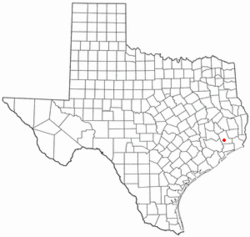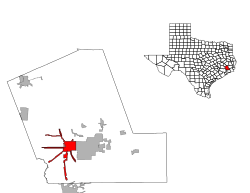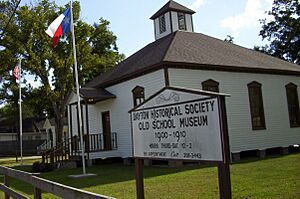Dayton, Texas facts for kids
Quick facts for kids
City of Dayton
|
|
|---|---|
 |
|

Location in the state of Texas
|
|
 |
|
| Country | United States |
| State | Texas |
| County | Liberty |
| Founded | 1831 as West Liberty |
| Incorporated | May 3, 1911 - Aug 29, 1911; Nov 28, 1925 |
| Government | |
| • Type | Council–manager |
| Area | |
| • Total | 30.70 sq mi (79.51 km2) |
| • Land | 30.66 sq mi (79.41 km2) |
| • Water | 0.04 sq mi (0.10 km2) |
| Elevation | 66 ft (20 m) |
| Population
(2020)
|
|
| • Total | 8,777 |
| • Density | 273.60/sq mi (105.64/km2) |
| Time zone | UTC-6 (CST) |
| • Summer (DST) | UTC-5 (CDT) |
| ZIP code |
77535
|
| Area code(s) | 936 |
| FIPS code | 48-19432 |
| GNIS feature ID | 2410300 |
Dayton is a city located in Liberty County, Texas, in the United States. In 2020, about 8,777 people lived there.
Contents
Exploring Dayton's Location
Dayton is a city in Texas. It covers an area of about 30.70 square miles (79.51 square kilometers). Most of this area is land.
Dayton's Climate
The weather in Dayton is usually hot and humid in the summer. Winters are generally mild or cool. This type of weather is called a humid subtropical climate. It means there is a lot of moisture in the air.
Dayton's Population and People
Dayton has grown quite a bit over the years. Here is how its population has changed:
| Historical population | |||
|---|---|---|---|
| Census | Pop. | %± | |
| 1870 | 230 | — | |
| 1890 | 239 | — | |
| 1930 | 1,207 | — | |
| 1940 | 1,279 | 6.0% | |
| 1950 | 1,820 | 42.3% | |
| 1960 | 3,367 | 85.0% | |
| 1970 | 3,804 | 13.0% | |
| 1980 | 4,908 | 29.0% | |
| 1990 | 5,151 | 5.0% | |
| 2000 | 5,709 | 10.8% | |
| 2010 | 7,242 | 26.9% | |
| 2020 | 8,777 | 21.2% | |
| U.S. Decennial Census 1850–1900 1910 1920 1930 1940 1950 1960 1970 1980 1990 2000 2010 *1870 as West Liberty |
|||
In 2020, there were 8,777 people living in Dayton. They lived in 2,892 households. About 2,115 of these were families.
Who Lives in Dayton?
The people living in Dayton come from many different backgrounds. Here is a look at the different groups in 2020:
| Group | Number of People | Percentage |
|---|---|---|
| White (NH) | 5,029 | 57.3% |
| Black or African American (NH) | 1,314 | 14.97% |
| Native American or Alaska Native (NH) | 30 | 0.34% |
| Asian (NH) | 133 | 1.52% |
| Pacific Islander (NH) | 2 | 0.02% |
| Some Other Group (NH) | 32 | 0.36% |
| Mixed/Multi-Racial (NH) | 385 | 4.39% |
| Hispanic or Latino | 1,852 | 21.1% |
| Total | 8,777 |
In 2000, about 30% of the people were under 18 years old. About 12% were 65 years or older. The average age was 33 years old.
Dayton's History
Dayton has had a few different names over time. It was once called West Liberty, Day's Town, and Dayton Station. The city was first started in 1831 as West Liberty. It was located west of the Trinity River.
Dayton was originally part of the City of Liberty. But in 1898, people living in Dayton voted to become a separate city. Dayton officially became a city in May 1911. However, a big fire happened in August 1911. After the fire, people voted to un-incorporate. Dayton then voted to become a city again on November 28, 1925.
Getting Around Dayton
Dayton is connected to other places by roads and railways.
Major Highways in Dayton
- U.S. Highway 90: This is a main road that goes through Dayton. It heads west towards Crosby and Houston. To the east, it goes into East Texas towards Beaumont and then to Louisiana.
- SH 321: This highway connects Dayton to Cleveland. In Dayton, it is called North Cleveland Street.
- SH 146: This road links Dayton to Baytown.
- FM 1960: This road connects Dayton to the northern parts of Houston, as well as Humble and Huffman.
- FM 1409: This road connects Dayton to Old River-Winfree.
- Texas State Highway 99: This is a loop toll road that crosses U.S. Highway 90. It connects Dayton to other areas around Greater Houston.
Railroads in Dayton
Dayton is an important spot for trains. Two main train lines meet here. One is a north-south line run by Union Pacific (UP). The other is an east-west UP line that generally follows U.S. Highway 90. The BNSF also uses some of these tracks.
Learning in Dayton
Students in Dayton attend schools in the Dayton Independent School District. After high school, students from Dayton ISD can attend Lee College. The city also has the Jones Public Library, which is a great place to find books and learn new things.
Famous People from Dayton
Many interesting people have come from Dayton, including:
- Don Brown, a football player
- Bill Daniel, who was a governor of Guam
- Marion Price Daniel, Sr., a former governor of Texas
- Julie Kocurek, a lawyer and judge
- Mike Mabry, an American football center
- John Otto, an American politician
- Aaron Ripkowski, a football player
See also
 In Spanish: Dayton (Texas) para niños
In Spanish: Dayton (Texas) para niños


